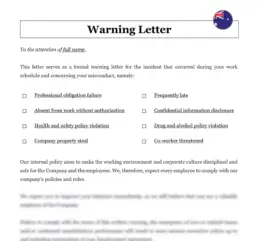The Role of an Employee Warning Letter
An Employee Warning Letter is an essential tool for addressing misconduct in the workplace. It serves as an official document that notifies an employee of their unacceptable behavior and outlines the consequences if the behavior continues. This letter is not just about documenting the issue; it’s also a key step in ensuring that the employee understands the seriousness of the situation and has an opportunity to correct their actions. Using an Employee Warning Letter appropriately can help prevent further issues and support a fair process, which is critical in maintaining a positive workplace environment.
Understanding Employee Misconduct
The structure of your Employment Application should be straightforward and user-friendly.
1. Personal Information: Start with basic information such as name, contact details, and eligibility to work in Australia.
2. Employment History: Include sections for previous job roles, responsibilities, and achievements.
3. Skills and Qualifications: Ask applicants to list relevant skills and qualifications, focusing on those most critical to the role.
The structure you choose should align with the specific requirements of your company. For instance, our article on Drafting Effective Building Agreements in Australia discusses how structure and clarity are essential in legal contracts, much like in employment applications.
The Importance of Documenting Misconduct
Documenting incidents of misconduct is critical for building a clear record of events, which is necessary for justifying any disciplinary actions taken. The Employee Warning Letter plays a significant role in this documentation process.
1. Clarity: Clearly outline the behavior that constitutes misconduct and reference specific incidents with dates and details.
2. Consistency: Ensure that similar cases of misconduct are documented and addressed consistently to avoid claims of unfair treatment.
3. Legal Protection: Proper documentation, including Employee Warning Letters, can protect your business in case of legal disputes, ensuring that there is evidence of due process.
Steps to Issuing an Employee Misconduct Notice
When issuing an Employee Warning Letter, it’s important to follow a structured process to ensure that the letter is effective and legally compliant.
1. Investigation: Conduct a thorough investigation to gather all relevant facts before deciding to issue a warning letter.
2. Meeting: Arrange a meeting with the employee to discuss the misconduct, allowing them to explain their side of the story.
3. Issuance of the Warning Letter: After the meeting, if the misconduct is confirmed, issue the warning letter outlining the behavior, expected improvements, and potential consequences of repeated offenses.
4. Follow-Up: Monitor the employee’s behavior after issuing the warning letter and provide additional support or training if necessary.
Key Elements of an Employee Misconduct Notice
An effective Employee Warning Letter should include several key elements to ensure clarity and fairness.
| ➤ Date and Employee Details: Include the date of issuance and the employee's name and position. |
| ➤ Description of Misconduct: Clearly describe the behavior that constitutes misconduct, including specific examples. |
| ➤ Previous Warnings or Discussions: Reference any previous warnings or discussions about the behavior, if applicable. |
| ➤ Consequences: Outline the potential consequences if the behavior continues, such as further disciplinary action or termination. |
| ➤ Expected Improvement: Specify what changes or improvements are expected from the employee. |
| ➤ Signature: Include space for both the employer and employee to sign, acknowledging the warning. |











